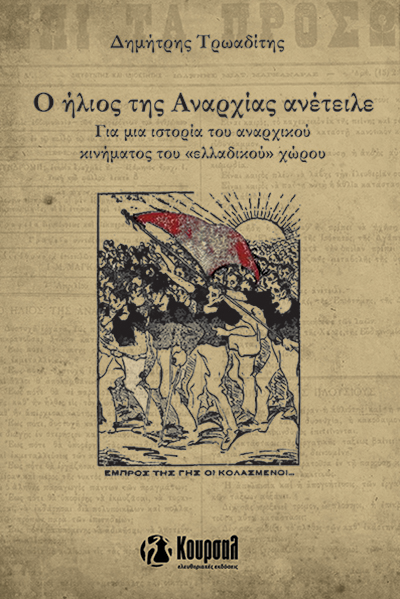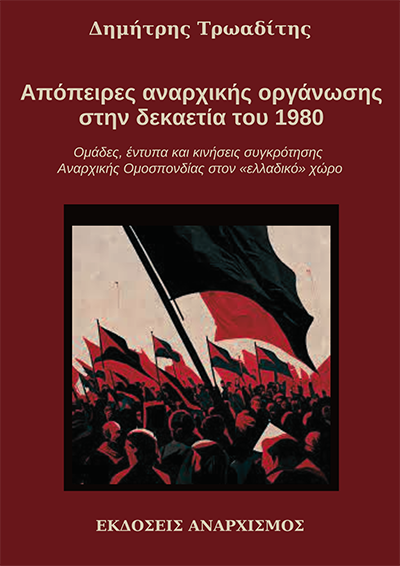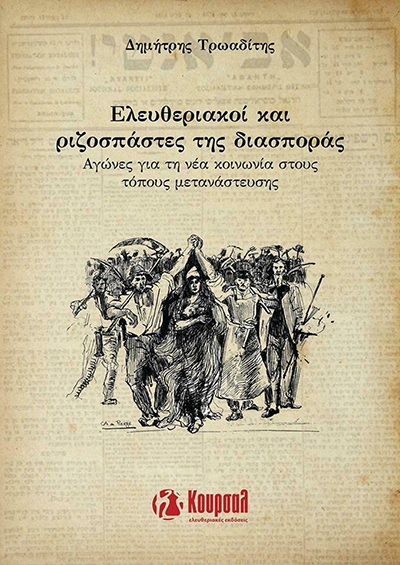Written by P. Pomonis
Part of the pamphlet “The early days of Greek Anarchism” published by KSL (end of the 19th - begining of the 20th century)
Social radicalism, which grew in Europe during the 19th century, marking future history with movements, revolts and revolutions, had an important influence in Greece. According to M. Demetriou: «....The ideas of social radicalism were introduced in Greece from Europe, with its ideological radiance and revolutionary traditions, in the 1870’s. In Europe, that period was marked by the 70 days of popular revolutionary power of the Paris Commune (1871)... At the same time, important social processes and changes, hitherto unbeknown to Greek society, took place. Socialist groups and labour unions were created... debates over socialism emerged and the first references to Karl Marx as the leader of the First International were made...»
In Europe, 19th century was marked by the rise and eventual dominance of the bourgeoisie; the rapid development of the productive forces; the development of the countryside; the big urban centers; the development of the proletariat and the emergence of socialist ideas. On the political level, absolutism fell and bourgeois democracy or constitutional monarchy were established. Of course, the victory of the bourgeois class had not been easy, but only came about as the result of hard fought struggles. In 1848 Europe was shaken by bourgeois democratic movements, social struggles and workers’ revolts. The supremacy of the bourgeoisie was consolidated, but at the same time the social radicalism of the working class and its allies was affirmed.
Subsequently the bourgeois liberal regimes further entrenched their power, and the working class increased in numbers. However, its revolutionary ardour was dampened, as a result of the improvement of living conditions. Skilled workers found themselves in an advantageous position and among them sprung a syndicalist bureaucracy as well as social democratic tendencies and views. Still, the labour movement organized, assertive and imbued with class and intemationalistic consciousness increasingly acted in solidarity with the national aspirations of the workers of other countries. The conjunction of class and internationalist consciousness, led the labour movement to various forms of international solidarity which culminated in the formation of the Ist International, whose fast demise was brought about by violent internal strife. In the following years capitalism further developed, while noteworthy events were the Paris Commune, the foundation of the Second International and the growth of anarchosyndicalism.
Contrarily to what went on in Europe, economic development in Greece proceeded at a very slow pace. In the second half of the 19th century, Greece witnessed a massive influx of the population into the big urban centers. This led to the hypertrophy of the services sector and the petit bourgeois strata, but it was not followed by a respective industrial growth: There were very few artisans and workers and too many professional small traders and brokers. In the countryside, there were small land owners, oppressed by the international division of agricultural production (single crop monoculture of raisin), as well as propertyless peasants brutally exploited by large estate owners, as was the case in Thessaly. However, the exodus of the rural population did not lead to widespread proletarisation, but remained motivated by petit bourgeois aspirations of employment in the small trade and in the services. Consequently, Greece lacked the clear cut class contrasts, which developed concurrently in Western Europe. However, the antagonisms between exploiters and exploited, intensified by periodic crises resulted in the deterioration of the condition of the lower strata.
During that period, and more precisely from 1870 onwards, socialist theories appeared in Greece, and as stated above, socialist groups and labour unions were created. Strikes seeking shorter working hours and better wages broke out. Several turned to armed clashes with the forces of the state and on many occasions they ended victorious. According to Kordatos’ «History of the Labour Movement»: «...Heeding to their class instinct, the workers undertook strike actions, which often brought success to the nascent labour movement». Such were the cases of the tobacco workers’ strike in Volos on 23/2/1901, the steamship sailors’ strike in Piraeus in 1910, the tobacco workers’ strike in Piraeus, the rail workers’ strike in Piraeus in 1910, the big strike in Lavrio in 1910, the tram drivers’ strike of January 1911 etc. These strikes were characterized by violent clashes with the forces of state and in some cases from machinery breaking and destruction of workplace installations. In the same period, peasant movements emerged and armed revolts broke out, especially in Thessaly (the Kileler uprising) and in the Peloponnesos. Socialist theories met with favourable response from workers and peasants.
Socialist theories and organizations varied. Accordingly, their methods and activities varied as well. Some were reformist, usually mere groups of intellectuals who did nothing but discuss between themselves about the abolition of poverty and injustice. Their activity was not subversive; they declared that by peaceful means the people should seek the improvement of its condition. Most important among them were the «visionary leaders», and their main representatives, Platon Drakoulis and Stavros Kallergis.
Platon Drakoulis published the magazine «Ardin», through which he propagated socialism, arguing for its superiority in respect to the other social systems. His actions were not subversive and he was characterized by his propaganda in favour of the historical necessity of a socialist paradise of social harmony. «...A radical theorist and not an activist, he didn’t elaborate on the dynamics of social antagonisms, he did not set objectives. He borrowed freely from various sources, from the gospels and Kropotkin, from Chartism and Plato’s Polity, in order to demonstrate the moral superiority of his vision -its historical necessity» wrote about him Michalis Demetriou. On 14-9-1885, Drakoulis wrote in «Ardin»: «It must be made clear that our aim is not subversive, as some fear and as many imagine. We seek a gradual and not a violent change in the state of things. We are enemies of unruliness, of paralysis, of subversions. On the other hand we are enemies of injustice and tyranny. Everybody says that the existing social order is bad and anomalous. That it is unjust that so many should suffer and so few should prosper.Down with privileges is the eternal cry of humankind and it will never be silenced as long as the inequality of rights between one man and the next is not eradicated».
Another personality among the reformist socialists, a leader as well, was Stavros Kallergis. Kallergis, the founder of a socialist club in Athens, published the newspaper «Socialistis». In 1891 he published «The worker’s encolpion”, in which he stated the necessary means for the establishment of the socialist polity, which we cite herebelow: «1) Creating clubs, aiming at the promotion and support of socialist ideas in various cities, townships and villages or neighborhoods 2) Publishing books, periodicals and newspapers with the same aim 3) Organising excursions to the countryside 4) Setting up halls aiming at the development of socialist ideals as well as socialist libraries 5) Supporting parliamentary delegates and mayors from the people, so that eventually the socialists shall gain the majority in parliament thus bringing the social question to its resolution 6) Organising of peaceful demonstrations and submitting memoranda to the parliament 7) Calling strikes aiming at the satisfaction of the demands of injured workers».
However, apart from the reformists, there were other socialists whose discourse and action was endowed with a subversive character. Their objectives were the abolition of private property, of the state and of every authority. It is the case of libertarian socialists or anarchists. In Athens and Piraeus their actions mainly revolved around syndicalism, while elsewhere (particularly in the Peloponnesos) they participated in peasant movements, revolts, armed demonstrations which ended in bloody clashes with the forces of the state. Moreover, there were anarchists, who followed the path of individual terrorism. Finally, there were Christian anarchists, who preached about the approaching end of times. As stated by M. Demetriou: «....These were not marginal phenomena, but ones that had a wider importance. They often represented the outlet of sociopolitical currents of the era, which remained impulsive and lacked guidance».
Anarchist ideas became known in Greece either from Greeks who had spent time abroad and had espoused revolutionary ideas, or by Italian anarchist refugees, many of whom became active in Greece, especially in the Peloponnesos. From 1870 onwards, the ideas of Bakunin, of Reclus, of Cafiero, of Kropotkin, of Emile Henry became familiar among many Greeks. As stated above, the Greek anarchists represented four tendencies: anarehosyndicalism, peasant anarchism, individual terrorism, and Christian anarchism.
Therefore we deem it necessary to deal with each tendency separately and thus refer to the individuals and the groups that were active at the time:
1) ANARCHOSYNDICALISM
2) In the end of the 19th century and in the first decades of the 20th, anarchosyndicalism exploded in several countries of Western Europe, Latin America and the United States. The defeat of its pinnacle, the Spanish Revolution, signaled its subsequent decline. Its main features were the belief in the merit of union struggles and the spontaneous proletarian revolution; the post revolutionary syndicalist structuring of society; atheism; decentralization; organizational autonomy; the objective of society run by unions, workers councils. In the past the majority of anarchists espoused anarehosyndicalism.
In Greece, anarchosyndicalism did not take roots. However, its contribution in the first major strike actions and in the creation of the first working unions was very significant. It should be noted that at the time, there were few industrial centers and the numbers of permanently employed industrial workers were limited to a few thousands. Still, those few industrial centers repeatedly became the battlefields of social clashes. The most important were Lavrio, Hermoupolis and Piraeus. The living standards of the workers were particularly low. The working day lasted 9-12 hours and even 15 hours, while the wages ranged from 75 to 240 golden drachma, which dropped by 30-40% in provincial cities. Anarchosyndicalism first manifested itself in Syros, in the wake of the monetary crisis triggered by the devaluation of the Russian rouble, which at the time was used for the payment of wages. In February 1879 strikes with protectionist demands were called in the tanneries and the snipping yards. The magistrate of Syros labeled this first strike activity as «the initial manifestation in «Greece of the clash between labour and capital». Owing to the scab activity of both the employers and the prefecture, the strike in the tanneries was accompanied by violent clashes with the militia, which left one policeman dead and many workers injured. Anarchosyndicalist ideas were propagated by Italian and French workers. The revolutionary traditions of their home countries and their political awareness made them suitable to act as catalysts. During the strike they created a «Workers’ League». Three years later the organization of anarchist workers of Syros issued the «People’s Gazette», which lasted briefly, from July to November of 1880.
Other important anarchosyndicalist organizations were the «Cosmos» League, constituted mainly by former Kalergite youths as well as the League of Anarchist Workers of Athens. The Anarchist League «Cosmos» spoke about the abolition of competition between human beings, the abolition of capital and the passing of private property and of all resources under common ownership. The culmination of its activity was the big strike in the Lavrio mines (a milestone in the history of the Greek Labour Movement). The strike, which sought higher wages, measures of social welfare, the establishment of Sunday as a day of rest as well as the implementation of security measures to curb the number of accidents in the mines lasted for 20 days and acquired an insurrectionary outlook. It was accompanied by damages to buildings, explosions, clashes, beatings of representatives of the bosses and it was bloodily suppressed by the army and the police.
As for the League of Anarchist Workers of Athens, we do not know the date of its creation. We are aware of the views of its members from a memorandum they sent to the International Congress of Paris in 1900. Here follow two brief excerpts:
«...The Anarchist Worker’s League of Athens rejects any form of parliamentary and legal action, and acknowledges as the only route of subversion, that of direct and antiparliamentary action. Deeming that any representation and legislation is nothing but the negation of the absolute freedom of the individual. Deeming moreover, that authority corrupts even the best among men, we conclude that we have nothing to look forward to either from parliamentary socialist democracy or from the parliamentary delegates of the revolutionary groups....»
«The League of Anarchist Workers of Athens does not acknowledge within its ranks any form of Administration or Commission, anything that could be construed as a government, as authority».
This was the last manifestation of anarchosyndicalism in Greece and after 1910 it petered away.




